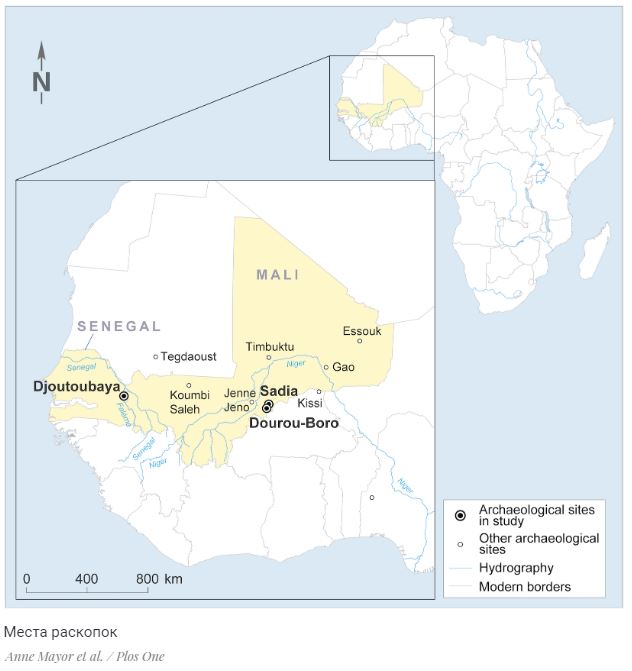Господдержка предприятий-производителей строительных материалов

Chemical analysis of glass beads from three archaeological sites in West Africa showed that the states that existed here at that time traded with Egypt, Mesopotamia, the eastern Mediterranean and the peoples of Central Africa, and the exchange network extended beyond the main trade centers and even reached remote villages. This is stated in a study published in the journal Plos One.
Glass was invented nearly four thousand years ago, and the first item made from this synthetic material was beads. They have a lot to say about the culture, customs and trade routes of ancient societies, as the manufacturing techniques and raw materials for glass changed from era to era and from region to region, so the origin of the beads can be determined through chemical analysis.
Anne Mayor and her colleagues at the Laboratory of Archeology and Population for Africa at the University of Geneva have been conducting archaeological excavations for many years in West Africa, central Mali and eastern Senegal. Prior to the beginning of European colonization in the 16th century, local states existed here - the empires of Ghana, Mali and Songhai. In 2007-2018, archaeologists excavated at three sites: the Duru-Boro rock burial site, the area with five Sadia settlements in central Mali, and the Jutubaya settlement in eastern Senegal. Many artifacts were found there: clay shards, metal objects, stone beads, glass and glass jewelry.

AMS radiocarbon dating of the items showed that the tombs at Duru Boro were built in the 5th-6th centuries AD, and the last time burial was carried out there between 600 and 850 years. Items from Sadiya and Jutubai date from the 11th-13th centuries AD. In a new study, Anne Mayor's group selected glass beads as a study to clarify trade routes in West Africa at the time.
To do this, 16 glass beads from three locations were analyzed by mass spectrometry with laser ablation of samples - it allows you to determine the chemical composition of an artifact, finding signs of substances, even if they remain in trace concentrations - 20-500 particles per billion. After that, the composition of the beads was compared with the composition of the already known artifacts from the Mediterranean, Mesopotamia, continental Europe and the Middle East, since the centers of glass making in the 8th-15th centuries were located there. The only center for glass production in Africa at the time was at Ile Ife in southern Nigeria, so sub-Saharan glass beads were exotic.
Scientists have identified four chemical groups based on the composition of the glass: soda-calcium with a low content of lime and magnesia, soda-calcium with a high content of magnesia, soda-lime with a high content of magnesium, aluminum oxide (pure quartz sand) and soda-alumina glass with a high boron content. Each group contained impurities of other chemical elements. The composition of such glass coincided with samples from Mesopotamia (Nishapur, Samarra, Ctesiphon), Beirut, Damascus and the Levant lands, some from Egypt and Morocco.
Thus, jewelry was found in African settlements, glass for which was made in Egypt, the Middle East and the Eastern Mediterranean. Archaeologists have known before that international trade linked Africa with Europe and Asia as early as the Middle Ages. But this study is remarkable in that it showed the ramified nature of the trading network. If Duru-Boro and Sadiya were on the main trade routes of that time, then Jutubaya was far from urban centers.
This means that the exchange of imported materials is characteristic not only of the elite living in cities, but also of ordinary residents of rural areas. Duru Boro and Sadiya appear to have been linked by trade routes to other cities in the region, such as Timbuktu. And Jutubaya - with caravan routes to Audagosta and Kumbi-Saleh (modern Mauritania). It also turned out that the composition of the beads does not depend on the trade route. Beads with the same composition are equally found in all three archaeological sites. This means that they all communicated with Europe, Mesopotamia and the Mediterranean coast.
Chemical analysis of artifacts often helps archaeologists to reconstruct pictures of ancient life. So, mass spectrometry helped to find out the origin of a three-thousand-year-old hoard from the south of the Iberian Peninsula, and shards and decorations of the Babylonians found near Mount Zion are direct evidence of the destruction of Jerusalem and the First Jerusalem Temple during the Babylonian invasion.
Source: https://nplus1.ru/